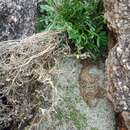Description
provided by Phytokeys (archived)
(Figs 38–43). Tap-rooted, strongly pungent smelling, decumbent, summer-green, perennial herb forming densely leafy, patches up to 1.5 m diam., and arising from stout, semi-circular, whitish-grey (when exposed) rootstock 3–10 mm diam. when fresh. Tap root fleshy, yellow to yellow-white when fresh, up to 300 mm long, deeply descending. Plants dying down in winter or in times of adversity to rootstock (in well-grown individuals the new season’s branchlets may die back to the previous season’s stem nodes). Stems prostate, weakly flexuous, divergent to widely spreading, 100–800 mm long, 0.8–5.2 mm diam., woody near base, initially spherical in cross-section, pale yellow-green to dark green, sometimes tinged maroon and finely puberulent with short papillate or tapered hairs; becoming glabrous and prominently ridged and/or grooved with age, and usually bearing numerous leaf scars and withered petioles; upper portion of stems sparingly and openly to heavily branched; branches and branchlets, usually very leafy. Leaves glabrous, firmly fleshy to succulent, glossy dark green to yellow-green, at senescence turning yellow. Rosette and lower stem leaves withering at fruiting; petioles distinct 10–50 × 1–3 mm, slightly concave in cross-section, fleshy; leaves glabrous above, with papillae or denticles along midrib beneath and margins in New Zealand plants, or without denticles (absent in Chatham Islands and most Australian plants); lamina 50–90 × 15–30 mm, pinnatifid, obovate to oblanceolate; pinnae in 1–3 pairs, bluntly toothed or crenate at apex and distal margins. Upper stem leaves glabrous above, usually with triangular denticles, dense on margins and sparse to dense beneath (although absent in Chatham Islands and most Australian plants); mostly apetiolate, petiole if present minute up to 1.5 mm long; lamina 5–30 × 3–10 mm, obovate, oblanceolate, or spathulate, apex bluntly toothed to crenate, base broadly to narrowly cuneate. Racemes 10–50 mm long, elongating up to 60 mm at fruiting, terminal and leaf-opposed; rachis and pedicels puberulent with short tapering hairs, and ± covered in triangular denticles (absent in Chatham Islands and most Australian plants) or glabrous; axillary; rachis and pedicels hairs if present, retrorse to patent, very short, 0.05–0.8 mm long, ± clavate, eglandular – glandular; pedicels, erecto-patent to patent, initially 1.04–1.27(–2.38) mm; elongating to 2.34–5.00(–6.02) mm long at fruiting. Flower buds dark green, apex bearing a conspicuous, caducous, crest of white, eglandular, antrorse hairs up to 0.9 mm long. Flowers sweetly fragrant, 1.4–1.8(–2.3) mm diam. Sepals, broadly ovate to oval, apex broadly obtuse, centrally green with a white margin, deeply concave, adaxially weakly keeled, adaxial midrib invested in conspicuous, caducous, white, eglandular, antrorse, hispid hairs, hairs sometimes scattered across rest of adaxial surface; abaxial surface glabrous; lateral sepals broad, 0.6–1.0 × 0.6–1.2 mm , median sepals narrower 0.4–0.8 × 0.4–0.7 mm. Petals white, 0.3–0.8(–1.0) × 0.2–0.8 mm, erecto-patent or patent, clawed; limb broadly obovate, apex obtuse, retuse or distinctly emarginate. Stamens 2, equal. Anthers c.0.16 mm long. Pollen bright yellow. Nectaries 4, subulate, 0.40 mm long. Silicles cartilaginous when fresh, subcoriaceous when dry, (2.1–)3.3(–4.1) × (2.2–)3.3–3.4(–4.0) mm, orbicular, obovate, to ovate, slightly winged in upper ¼, apex scarcely or shallowly notched, valves green maturing yellow-green, glabrous; style 0.8 (–1.0) mm long, free from the narrow wing, equal to or slightly exceeding the notch; stigma 0.2–0.4 mm diam. Seeds 2, 1.20–1.38 × 0.80–1.10 mm, ovoid to suborbicular, red-brown, dark red-brown or brownish black, not winged. FL. Oct–Feb. FR. Dec–Apr.
- license
- cc-by-3.0
- copyright
- P. J. de Lange, P. B. Heenan, G. J. Houliston, J. R. Rolfe, A. D. Mitchell
- bibliographic citation
- Lange P, Heenan P, Houliston G, Rolfe J, Mitchell A (2013) New Lepidium (Brassicaceae) from New Zealand PhytoKeys 24: 1–147
- author
- P. J. de Lange
- author
- P. B. Heenan
- author
- G. J. Houliston
- author
- J. R. Rolfe
- author
- A. D. Mitchell
Distribution
provided by Phytokeys (archived)
(Fig. 44). Indigenous. Australia (Tasmania) and New Zealand (North, South, Chatham islands). In the North Island of New Zealand, Lepidium flexicaule is now known from only two extant populations, one on Saddle Island off the west coast of Great Barrier Island (Aotea Island) (de Lange and Cameron 2011) and the other at Stent Road north of Cape Egmont, Taranaki (Peet et al. 2003). Historically Lepidium flexicaule was present on Rangitoto Island, along the Waitakere Coastline, near North Head, Waitemata Harbour and near Onehunga, Manukau Harbour (Kirk 1899; Cheeseman 1906, 1925; Garnock-Jones and Norton 1995). It was also recorded from the Firth of Thames, at Mercury Bay (Kirk 1899; Cheeseman 1906, 1925; Garnock-Jones and Norton 1995) and near Wellington (Garnock-Jones and Norton 1995). In the South Island, the species is confined to the western coast of North-West Nelson from near Kaihoka to about Point Elizabeth. Lepidium flexicaule was discovered on the northern portion of Rekohu in 2005 by Department of Conservation botanists.
- license
- cc-by-3.0
- copyright
- P. J. de Lange, P. B. Heenan, G. J. Houliston, J. R. Rolfe, A. D. Mitchell
- bibliographic citation
- Lange P, Heenan P, Houliston G, Rolfe J, Mitchell A (2013) New Lepidium (Brassicaceae) from New Zealand PhytoKeys 24: 1–147
- author
- P. J. de Lange
- author
- P. B. Heenan
- author
- G. J. Houliston
- author
- J. R. Rolfe
- author
- A. D. Mitchell

